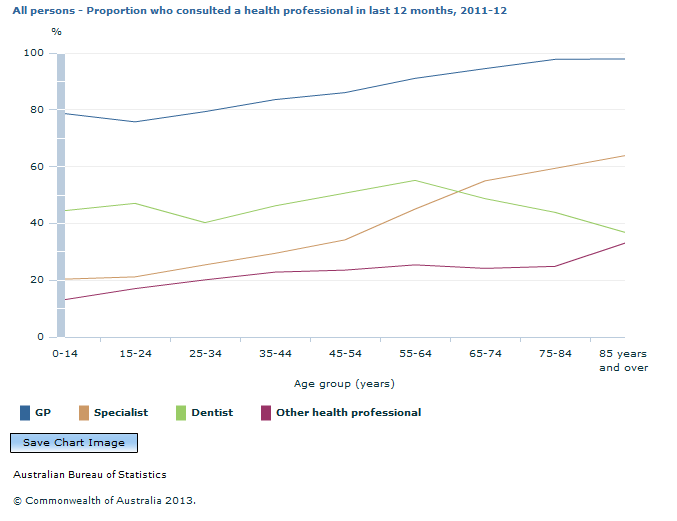4364.0.55.002 - Australian Health Survey: Health Service Usage and Health Related Actions, 2011-12
ARCHIVED ISSUE Released at 11:30 AM (CANBERRA TIME) 26/03/2013 First Issue
Page tools:
 Print Page Print Page
 Print All Print All
| ||||||
By regularly monitoring their health, people may help prevent illness or injury. Consultations with health professionals may assist in many ways, including the monitoring of lifestyle risk factors, the treatment and management of long-term health conditions as well as short-term illness and injury, and the maintenance of good health. In 2011-12, around 20.1 million people (91.1%) had consulted a health professional in the last 12 months. GPs were the most commonly visited health professional with 83.8% of people seeing a GP in the last 12 months (unchanged from 2004-05 at 83.0%), while 32.1% of people had consulted a specialist, 46.8% had visited a dentist, and 20.6% had consulted an other health professional. Proportionally more women than men had consulted a health professional in the last year (93.9% compared with 88.3% respectively). As expected, older Australians were more likely to consult health professionals than younger Australians. Almost all people aged 85 years and over (98.0%) had consulted a GP in the last 12 months (compared with 78.7% of people under 15 years), while 63.9% of people 85 years and over had consulted a specialist in the last 12 months (compared with 20.4% of people under 15 years). However, the proportion of people visiting dental professionals declined after 65 years of age.  The most common lifestyle issues discussed with a GP related to improving diet and losing weight. The top three issues discussed were 'reaching a healthy weight', 'eating healthy food or improving diet' and 'increasing physical activity'. People aged 45-74 years were most likely to discuss these lifestyle issues with their GP. People living in areas of relatively high disadvantage were less likely to have seen a dentist (35.9% compared with 59.2% respectively) or a specialist (30.1% compared with 35.7% respectively) in the last 12 months than people living in areas of low disadvantage.  Footnote(s): (a) Index of Relative Socio-Economic Disadvantage: a lower Index of Disadvantage quintile (e.g. the first quintile) indicates relatively greater disadvantage and a lack of advantage in general. A higher Index of Disadvantage (e.g. the fifth quintile) indicates a relative lack of disadvantage and greater advantage in general. See Index of Relative Socio-Economic Disadvantage in the Glossary. Source(s): Australian Health Survey: Health Service Usage and Health Related Actions People living in outer regional and remote areas were less likely to have consulted a health professional in the last 12 months, compared with people in major cities. While nearly 1 in 3 (32.8%) people living in a major city had consulted a specialist in the last 12 months, 27.6% of people living in outer regional and remote areas had done so. The proportion of people who visited a dentist dropped from 48.8% for people living in major cities to 41.1% for people in outer regional and remote areas. The proportion of people consulting an other health professional fell from 20.6% in major cities to 16.4% in outer regional and remote areas. GP visits were relatively similar across remoteness areas. For more information see Table 1: Selected health service usage and health actions taken, Table 3: Selected health service usage by selected population characteristics and Table 5: Selected health risk factors by health service usage and health actions taken.
|
||||||
